Light
Light is a form of energy that travels away from the source that produces it at a speed of 3×108 m s-1
Crooke’s Radiometer
Converts light energy into kinetic energy.
- shows that light is a form of energy
Light usually travels in straight lines
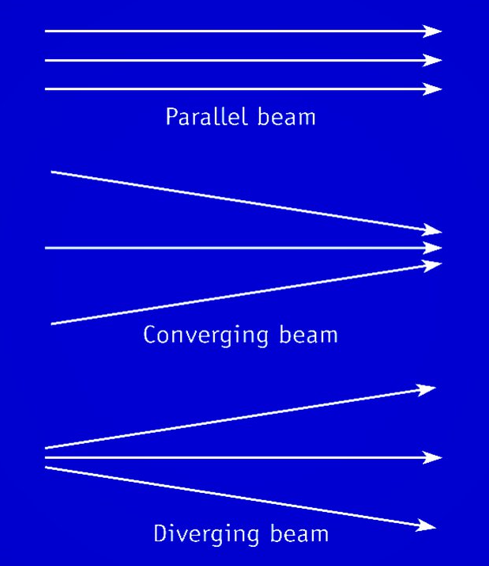
Reflection of Light
The bouncing of light from the surface of an object.
There are two types of reflection, diffuse and regular.
Diffuse Reflection
When light strikes a matt surface (non smooth surface) the reflected light is scattered in all directions.
Most everyday objects are visible by light which has been diffusely reflected from them.
Regular Reflection
If the surface that the light strikes is silvered and polished smooth (e.g. a mirror) the light is not scattered and reflected directly.
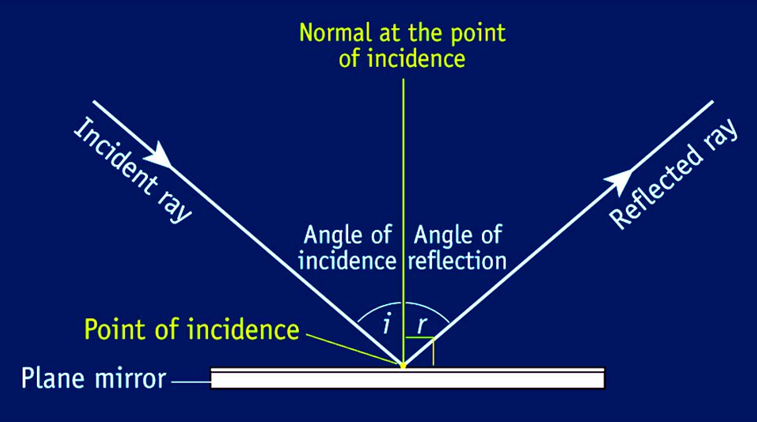
Laws of Reflection of Light
Law 1:
The incident ray, the normal at the point of incidence, and the reflected ray all lie in the same plane.
Law 2:
The angle of incidence is equal to the angle of reflection.
Optics
There are two types of images:
- real images
- virtual images
Virtual Image:
An image formed by the apparent intersection of rays.
A virtual image cannot be formed on a screen.
Image in Plane Mirror:
A virtual/upright/the same distance behind the mirror as the object is infront of the mirror.
Objects are flipped (lateral inversion) e.g. ambulance in rear view mirror
The apparent movement of one object relative to another due to the motion of the observer is called parallax. The object that is farthest away appears to move with the observer.
Reflection of Light from Spherical Mirrors
Concave and Convex Mirrors
The reflecting surface of a concave mirror caves in at the centre.
The reflecting surface of a convex mirror bulges out at the centre.
Describing Concave and Convex Mirrors
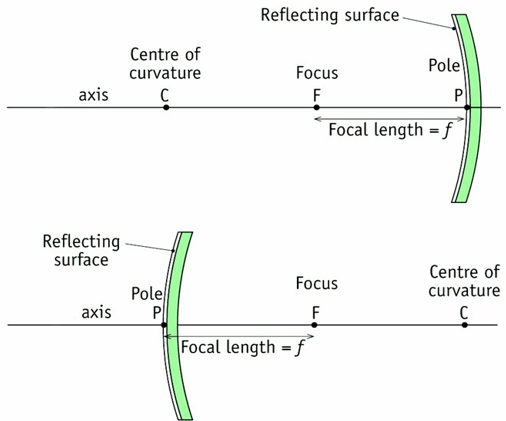
1. When a ray strikes the pole of a concave
mirror it is reflected at an equal angle with the axis.
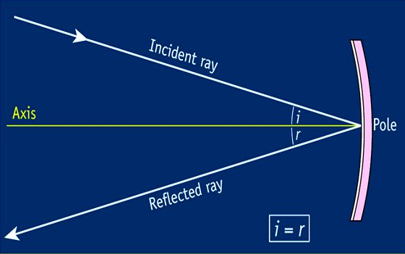
2. When a ray passes through the centre of curvature
of a concave mirror it is reflected back along its on path.

3. When a ray comes parallel to the axis and strikes
a concave mirror it passes through the focus after reflection.
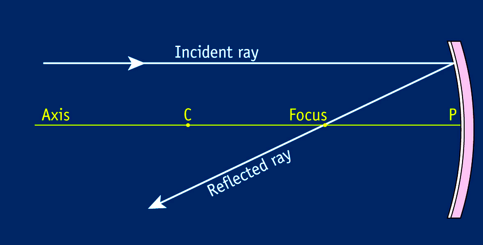
4. When a ray passes through the focus and strikes
a concave mirror it is relfected out parallel to the axis.
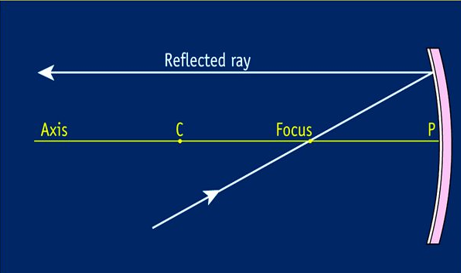
Real Image
An image formed by the actual intersection of rays.
A real image can be formed on a screen.
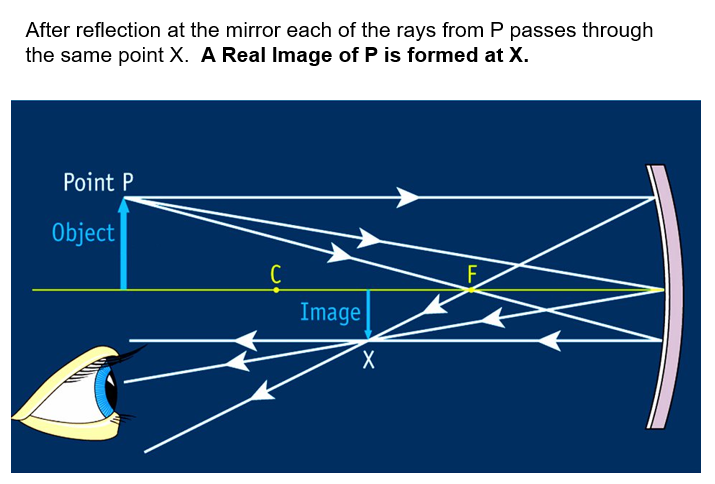
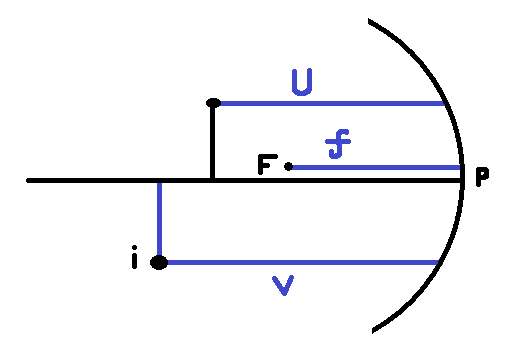
u = object distance to mirror
v = image distance to the mirror
f = focal length
Uses of a Concave Mirror
Dentist’s Mirror
Floodlights
Projector
Torch
Solar Furnace
Cosmetics Mirror
Formulae for Concave Mirrors
Real Image
1/u + 1/v = 1/f
Virtual Image
1/u - 1/v = 1/f
Magnification
m = v/u
Focal Length from Radius
f = r/2
Qualities of Images Formed by a Concave Mirror
Outside Focus:
Image = Real, Magnified, Upside Down
On Focus:
Image = Formed at infinity
Inside Focus:
Image = Virtual, Magnified, Upright
Outside Centre of Curvature:
Image = Real, Diminshed, Upside Down
Convex Mirrors
In a convex mirror, the image is always virtual.
Formulae for Convex Mirrors
Virtual Image
1/u - 1/v = -1/f
Magnification
m = v/u
Focal Length from Radius
f = r/2
Rules for Convex Mirrors
Rule 1
Ray that strikes the pole is reflected at an equal angle with the axis.
Rule 2
Ray that is heading for the centre of curvature is reflected along back its own path.
Rule 3
If a ray is parallel to the axis then it reflects as if it came from the focus behind the mirror.
Rule 4
A ray that is heading for the focus and strikes the mirror is reflected out parallel to the axis.
Refraction
The bending of light when it goes from one medium to another.
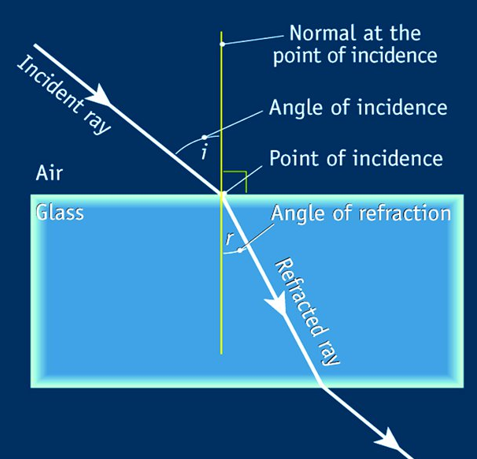
As the angle of incidence increases, so does the angle of refraction. However they do not increase proportionally.
When light travels from a rarer medium to a denser medium, it is refracted towards the normal.
When light travels from a denser medium to a rarer medium, it is refracted away from the normal.
Laws of Refraction
Law 1: The incident ray, the normal at the point of incidence and the refracted ray all lie in the same plane.
Law 2: The ratio of the sine of the angle of incidence to the sine of the angle of refraction is a constant
sin i
—— = n, where n is constantsin r
Snell’s Law
Snell’s law states that the ratio of the sine of the angle of incidence to the sine of the angle of refraction is constant.
Refractive Index
The ratio of the sine of the angle of incidence to the sine of the angle of refraction when light travels from air into that material.
Due to refraction an object in liquid appears at a lesser depth than it actually is.
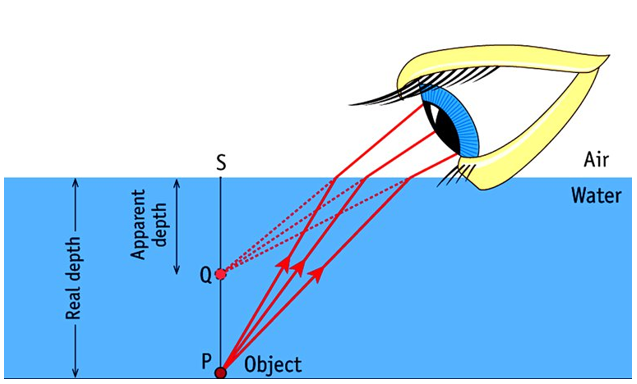
The apparent depth decreases as you view the object more from the side. The apparent depth is greatest when the object is viewed from vertically above it.

Real Depth and Apparent Depth
An object is viewed from air through another medium and the line of view is perpendicular to the surface of the medium.
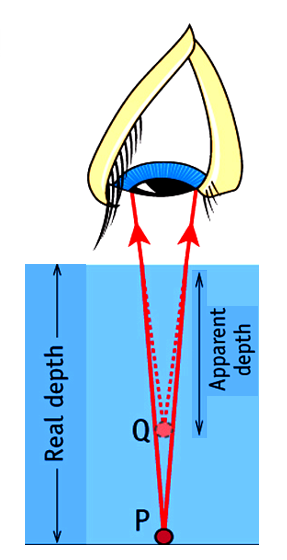
Real Depth
——————— = n
Apparent Depth
Refractive Index in Terms of Relative Speeds
sin i C1
—— = —-- = 1n2
sin r C2
speed of light in air
——————————— = speed of light in water
refractive index of water
Critical Angle
When light travels from a denser to a rarer medium the angle of incidence whose angle of refraction is 90o is called the critical angle.
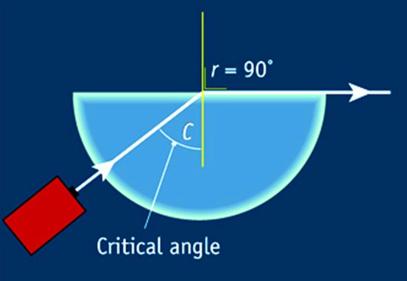
Total Internal Reflection
When light going from a denser to a rarer medium strikes the rarer medium at an angle greater than the critical angle, it does not enter the second medium. It is all reflected back in the denser medium.
When the critical angle is reached, the refracted ray skims along the flat face of the glass.
Increase angle of incidence further and total internal reflection occurs.
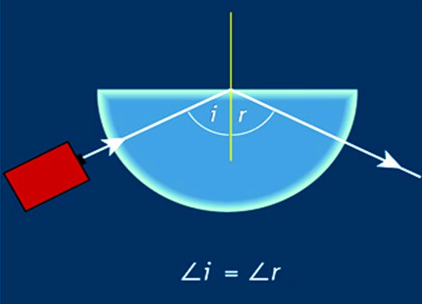
1
—— = nsin c
Turning of a Ray of Light Through 90o With a Prism
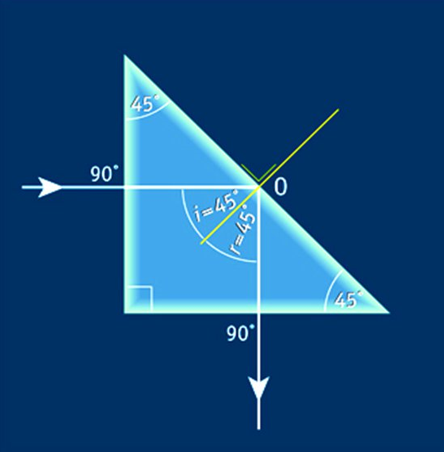
Turning a Ray of Light Through 180o With a Prism

Optical Fibres
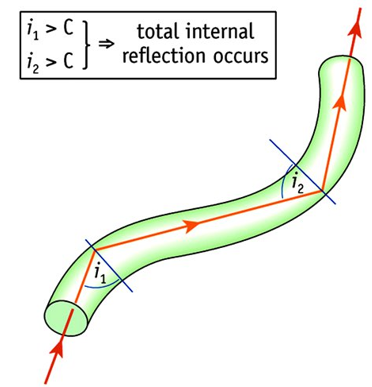
A very thin transparent rod (usually of glass) through which light can travel by total internal reflection is called an optical fibre.
If two optical fibres touch, light may escape from one and pass into the other.
Optical fibres are usually coated with glass of lower refractive index.
This ensures that light always stays in the inner denser glass even if two fibres touch eachother.
It also prevents damage to the surface of the denser inner fibre.
 Knowt
Knowt